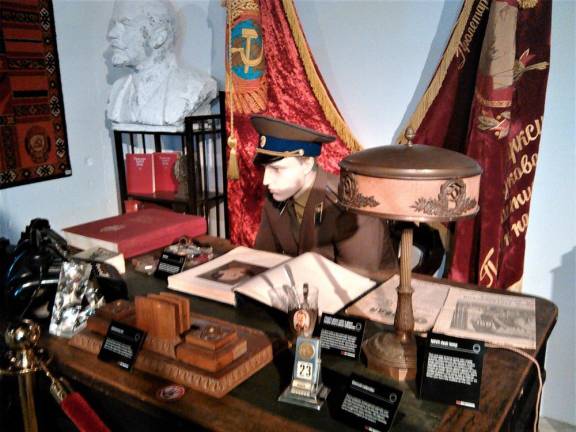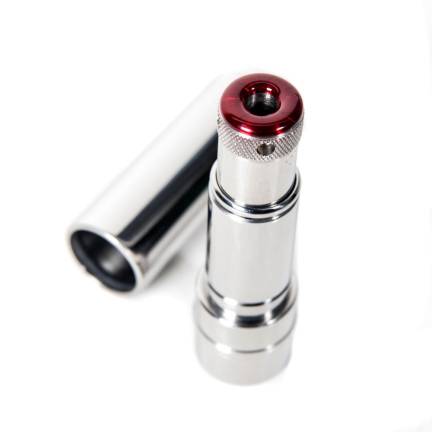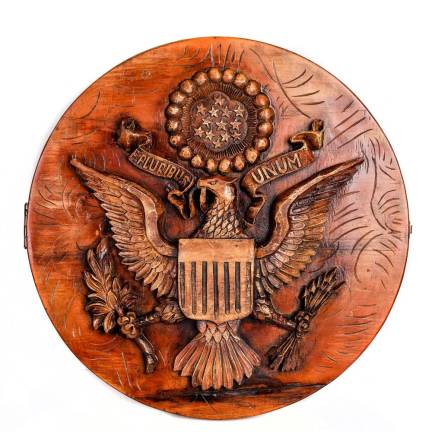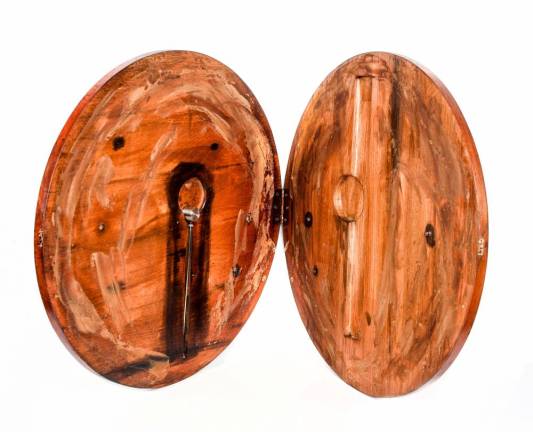The world’s only KGB Espionage museum greets visitors with a “Lifestyles of the Communist and Fabulous” scene: a KGB officers’ desk, complete with decorative KGB lamp (supposedly owned by Stalin), a desk set, a silver tea set, a huge safe with a stash of rubles, and a high-end mahogany radio/record player that may have found its way to Comrade Stalin’s home.
If it’s good to be king, it’s really good to be First Comrade.
Everyone else was under surveillance. Walking through the nearly 4,000-square foot museum on 14th Street near the High Line is a literal walk through the history of the Soviet surveillance state, starting with the pre-KGB KNVD, the KGB itself and the post-KGB FSB. Compelling exhibits illustrate its history, its practices and its tools for enforcing loyalty and punishing non-conformity.
For instance, one of the relics of the power of the state is an umbrella – and it’s a killer. Dissident Georgi Ivanov Markov was murdered with one just like it in 1978, in the United Kingdom. A cutaway in the replica reveals the needle hidden in the tip to deliver fatal ricin with the push of a button. It’s just one of the museum’s 3,700 artifacts. They are as large as a switchboard, as small as a lipstick, as silly as a fake wig, as serious as a torture chair.
State-Sponsored Horror
The museum mix includes old-school propaganda and the truly horrid. Just past 16 posters of heroic peasants and chubby, red-cheeked children looking happily into a Soviet future, visitors encounter a hideous tool of the surveillance state: The Tramp Chair.
The leather straps on this huge, wooden chair secured the arms, legs and chest of “patients” at the Kazan Special Psychiatric Hospital. Strapped in for weeks, they were beaten, injected with dangerous drugs or gases or drilled by sadistic dentists. Medieval? Hardly. Some 10,000 people were ‘treated” from 1935 ... to 1991. (Now, though, visitors are invited to ‘have a seat” and take a selfie.)
The most compelling artifact is on the rear wall: huge metal doors taken from an actual KGB prison. Inside tiny 12-square-inch openings are chilling videos that recreate prison life in “soft cells" - padded in leather to smother screams and prevent prisoners from hurting themselves by banging their heads against the walls - and "courtyard cells," where prisoners could walk under open sky (and watchful guards). “Many prisoners thought the walk to this cell would be their last,” said Agne Urbaityte, whose father, Julius Urbaitis, assembled the collection over more than 25 years.
Urbaityte and her father are recent arrivals from Lithuania, where the collection was housed originally. Julius is a dedicated, almost obsessive writer, scholar, lecturer and collector – at one time he had the largest collection of gas masks in Europe, his daughter said proudly. “There are auctions, or estate sales or private collections where someone knows someone who knows someone in the KGB,” Urbaityte explained. While some artifacts are replicas, others, like the KBG prison doors, are authentic.
The KGB collection took time to gather, she said, because they wanted authentic items when possible; in exhibit placards (they wrote all the notes themselves) they carefully identify replicas (like the poison umbrella) or speculate when something – say Stalin’s Victrola near the entrance – was ‘likely given’ to the First Comrade.
Spy Tech Galore
The dozens of glass cases in the large open space hold less forbidding artifacts and create a winding maze through Soviet spy technology – with enough cameras, listening devices, and copying technologies to fill a good-sized vintage electronics shop. There are tiny listening devices hidden in pens, wallets, ties, tie clips, radios (naturally), hats, doctor bags, and workmen’s tool bags – just about every conceivable place to hide a listening device.
The standout exhibit was dubbed “The Thing” by the Soviets, but we would recognize it as the Great Seal of the United States. It’s a duplicate of the wooden U.S. seal presented by “Soviet schoolchildren” to a completely oblivious U.S. Ambassador W. Averell Harriman in 1943. It hung in his Moscow office for years while the ingenious bug hidden inside of it (no power supply needed) eavesdropped. The FBI didn’t discover the listening device until 1952.
And what’s a surveillance state without cameras to supply pictures of people, places, documents, inventions, or military locations? These miniature marvels were easy to operate, even when hidden in ties, belts, hats, buttons, birdhouses, umbrellas, cufflinks, shoes, a cigarette pack (which holds some real smokes), cosmetic cases, and even a ring capable of taking up to five pictures. Smile!
Killer Lipstick and Moose Tracks
There’s an artificial tooth holding a poison capsule, lock picks, and weapons hidden in ordinary objects like pens – or even a lipstick tube. “The Deadly Kiss” could fire a single bullet, and was, Urbaityte said, “most likely used in an intimate setting.” There’s even a gun concealed in a knife; apparently, the KGB didn’t mind a little overkill.
There’s no imaginable espionage ploy left unexplored, from secret messages on TV screens to the most far-fetched spots for recording devices – inside a tree, for example. And how would a KBG agent disguise his footprints in snow or mud while checking the tree for information? By wearing the special wooden clogs (on display nearby) over his shoes to mimic the tracks of a horse or moose. (Sorry, Bullwinkle).
At the end of the tour, visitors can check out the gift shop and have their photo taken at a KGB desk wearing an official hat and coat. Admission is $22 for adults, $13 for kids and $17 for students and seniors. Capitalism, it seems, won in the end ... at least for now.
IF YOU GO
What: The KGB Espionage Museum
Where: 245 West 14th St.
(917) 388-2332
kgbespionagemuseum.org
When: Seven days a week, 10 a.m. - 8 p.m.



